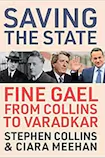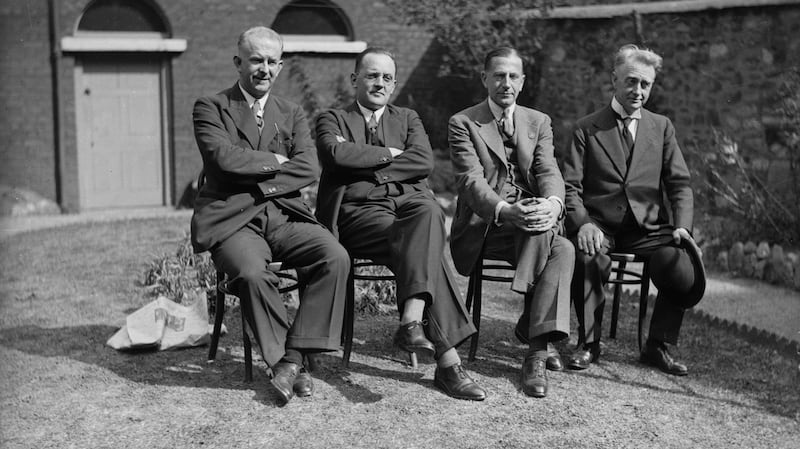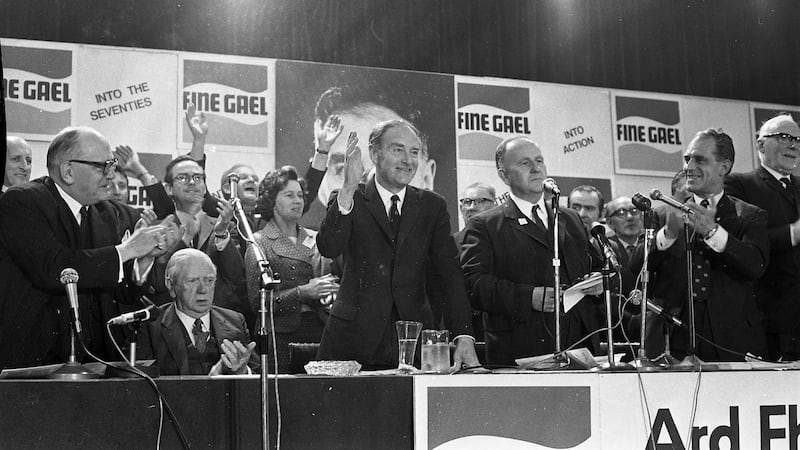
Towards the end of this book, Paschal Donohoe is quoted from an interview he gave to the authors in July. Reflecting on Fine Gael’s troubles in February’s general election campaign, he observed that to counteract the trends indicated by opinion polls that showed the party trailing Sinn Féin and Fianna Fáil, “We went back to basics. We focused back on the economy, the success with jobs and the risk of Brexit. Even though it wasn’t a message that chimed in with the population as a whole, it was successful in shoring up a base of Fine Gael voters.”
This was also about trying to shift the focus away from what was causing Fine Gael difficulty: in government it had not made enough progress in areas, again in Donohoe’s words, “like housing and health”.
I wonder in these comments did Donohoe inadvertently highlight that senior Fine Gael figures do not really consider health and housing as “basics” but instead see themselves as primarily addressing the business of “saving the State”, the arresting title of the book.
Fine Gael will be pleased with that title. They will also, I imagine, be more than happy with the content, which is very sympathetic to the party. Indeed, parts of it are gushing, so much so that party leader Leo Varadkar is given the last words of the book: “We are the party of enterprise and reward, we are the party of equality of opportunity. That has to be our identity, a positive identity.”
The book does not critically probe this kind of declaration and, given their professions, you would expect more bite from the authors, historian Ciara Meehan and veteran Irish Times political journalist Stephen Collins. At the outset they declare, “the book benefits, we believe, from the access that both of us have had over the years to various key figures in the political world”. It does, but that access also allows many of those “key figures” to drive a very flattering narrative, albeit an absorbing, pacy and accessible one.
Both authors have written extensively about the party: Collins in The Cosgrave Legacy (1996) and Meehan in The Cosgrave Party (2010) and A Just Society for Ireland? 1964-1987 (2013). Much of the content of these books has been recycled for incorporation here and the fact they have such a grasp of the party’s evolution and its major figures allows them to write confidently, in their own words, “through the lens of its different leaders . . . in this personality-driven study”.
But that approach, to my eye, compromises its objectivity. The authors have spent so long writing about the party that they give the impression of being grateful, if occasionally mildly frustrated, lodgers of a Fine Gael-owned house, bearing witness to the political family’s joys, rows, heaves, contrarians, handlers and strategists, all documented in interesting detail.
History
The party’s history is fascinating not least because, in the guise of Cumann na nGaedheal from 1922 to 1932, “it was a government before it was a party” arising out of the Civil War. It was also a party that “was all about government but spent most of its life in opposition”.
Cumann na nGaedheal’s first leader, WT Cosgrave, is depicted as a towering, resilient character who never lost his nerve as his party “rebuilt the country” and worked “with great success in international affairs”. Many of the State-building achievements and the stability achieved are rightly highlighted, but to depict Cosgrave’s opponents as “rough beasts slouching through the Ireland of the twenties” is crude, updated Civil War propaganda, the type used to dehumanise political opponents.
Fine Gael emerged in 1933 in the heat of a testing decade for democracy after Fianna Fáil took office in 1932. Its first president, Eoin O’Duffy, was at the forefront of what became the Blueshirts under the guise of the Army Comrades Association, renamed the National Guard, which then merged with Cumann na nGaedheal and the Centre Party to become Fine Gael.
O’Duffy has been excised from official party histories, yet his presidency of the new party was “not a problematic one at the time” given his highly regarded IRA and policing career. But as his devotion to extremism became more overt he became an embarrassing problem. The party preference instead is to focus on Michael Collins as the giant of its early years, which is a “problematic, selective interpretation of the party’s history” given that he died before its inception.

Fine Gael’s other leaders are duly, at times reverentially, documented, including John A Costello, Fine Gael taoiseach from 1948 to 1951, who instigated the removal of Ireland from the Commonwealth. The assertion that this “allowed the language of politics to move forward” is not convincingly explained, nor does it sit easily alongside the contention that it also “helped plant the seeds of what became the [IRA’s] Border campaign in the 1950s”. More convincing is the depiction of Costello as relatively effective in holding together a disparate coalition and the confidence it gave to the party by demonstrating “a workable alternative to single-party government”.
The second interparty government from 1954 to 1957 “faced up to painful decisions” and by permitting export tax relief and encouraging foreign capital apparently “created the foundations for the transformation of Ireland from a poor rural backwater on the edge of Europe to one of the wealthiest countries in the world in the first decades of the twenty-first century”, for which it got no credit. This is a premature, sweeping exaggeration given that other relevant ingredients for that transformation came much later.
The minutes of the parliamentary party from the 1950s suggest lethargy and laziness prevailed and there was much preoccupation with the traditional belief, articulated by party stalwart Gerard Sweetman, that the country needed “alternative governments rather than alternative policies”, as good a summary as any of the centrism of Irish politics by the 1960s.
Scepticism
Some scepticism is expressed about the Just Society episode for the party that decade (“at most an inspiring slogan”). This attempt to reposition the party by promoting greater equality through State intervention was slapped down by leader James Dillon, who insisted Fine Gael was a party of private enterprise”. But it did attract younger members such as Alan Dukes and John Bruton, two future leaders.
Liam Cosgrave took over the leadership in 1965 and while much is cited to challenge the idea that he was inherently conservative, his strongest interventions were to invoke Civil War ghosts at the outbreak of the Troubles and the Arms Crisis of 1970 in order to stress the party’s law-and-order credentials: “Soft-headed liberals are always talking about repression . . . not for the first time has this party stood between the people of this country and anarchy.”
Fine Gael and Labour continued to dance awkwardly around each other but served in coalition together from 1973 to 1977. The tenure of that government is well covered, though many of the sources cited relating to this period are particularly sympathetic to Fine Gael. There are interesting perspectives on the Garret FitzGerald years (1977-1987) and the use of advisers and “national handlers”.
The party’s national organiser, Peter Prendergast (also interviewed to trumpet his considerable achievements), shook up what he describes as a “pathetic” party organisation. He even hired two psychologists to conduct an analysis of the personality of Charles Haughey, who they concluded was indecisive. But, as is pointed out, Fine Gael’s election manifesto in June 1981, promising both spending and cutbacks, was hardly decisive either.
The contention of Garret’s son Mark that FitzGerald had to commit himself to a constitutional amendment on abortion to win the election of November 1982 “and rescue the country from what he believed was a dangerous government” goes unquestioned.
This theme of Fine Gael representing the national interest above all else is peddled hard, though the authors acknowledgde that FitzGerald (“a human dynamo” who really galvanised the grassroots) as taoiseach from 1982 to 1987, while far-sighted in his thinking and proposals about a more pluralist country, was a terrible chair of cabinet meetings and failed to fix the budgetary problems.
Cutting
Reference is made to Fitzgerald’s “generous, patriotic” call in 1987, after he lost office, for Dáil unity in dealing with the economic crisis, but he had not been capable of managing that crisis in government. And the cutting assertion by Eamonn Sweeney that FitzGerald has been “judged not by his achievements but by his intentions” is acknowledged as “arguably accurate”.
His successor Alan Dukes did not prove to be the answer to what the Evening Herald described in 1987 as a party in an “ideological no-man’s land”. Dukes was undoubtedly sharp-minded, but what is striking is how reliant he was on the proposals of others, including those from Peter White, the party’s young press secretary (another interviewee) regarding what became the Tallaght Strategy, promising not to oppose responsible economic management by Fianna Fáil.

Fine Gael’s 1990 presidential debacle, when its candidate Austin Currie floundered, is well recounted. White is hardly inaccurate in describing it as “like having a tooth extracted over two months”. There is a sympathetic portrayal of John Bruton and eventually, after numerous wobbles and the party’s frequent bouts of “soul searching”, the “confident and competent way he exercised power” from 1994 to 1997. Michael Noonan “never had his chance to find his feet as leader” and performed so poorly that once again “Fine Gael’s obituary was being written”.
The portrayal of Enda Kenny is of an optimistic, decisive and hardy leader with “amazing energy”. There is dense detail about how he faced down the heave by the Fine Gael posh boys and their backers. This stomps over well-covered ground but is still entertaining and enabled Kenny to survive so that the party could enjoy, in Brian Hayes’s words, “feasting over the carcass of Fianna Fáil” in 2011.
Kenny occasionally surprised us, as when he tore in to the Vatican over clerical child abuse. Former government press secretary Feargal Purcell makes the argument that because he came from the conservative wing of Fine Gael, Kenny managed to shift the party towards supporting a greater degree of social liberalism without splitting it.
And finally there is Leo Varadkar and his gushing acolytes. “He was an ideas factory in opposition,” they purr. Apparently, his humour on his Twitter feed has “won many over”. There is fair praise for his handling of the Brexit dilemma and the authors suggest the Covid-19 pandemic led to “Varadkar’s redemption”, but that was short-lived.
In his interview for the book Varadkar asserts there is “a kind of poetry” in the plan for him to become taoiseach in December 2022, 100 years after this State (or Fine Gael’s state, judging by the tenor of the book) came in to existence.
Fine Gael has contributed handsomely to this State’s evolution and stability, but so have their foes. What kind of political verse we will have by 2022 is far from clear.
Diarmaid Ferriter is professor of modern Irish history at University College Dublin and an Irish Times columnist. His book Between Two Hells: The Irish Civil War will be published next year by Profile Books









